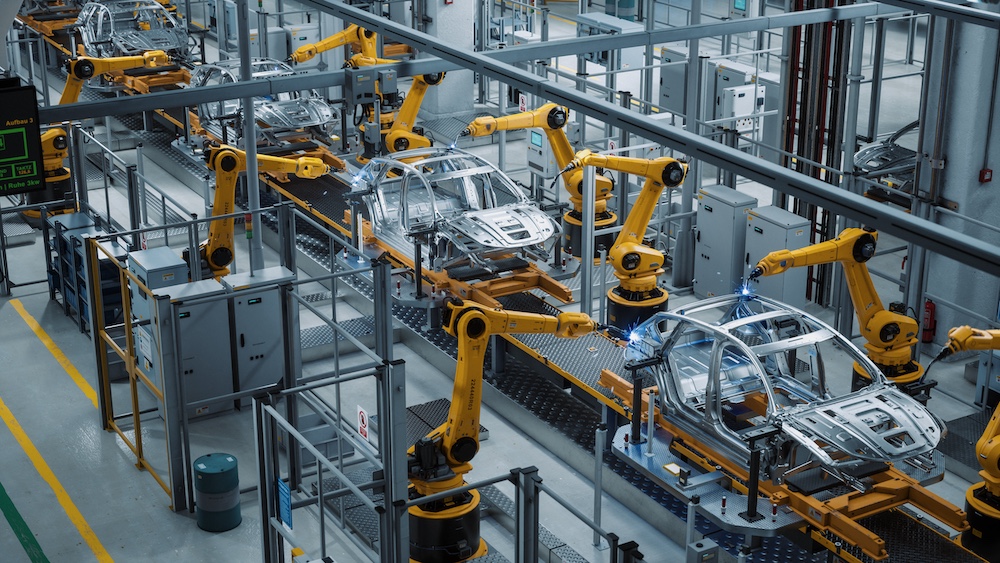In the fast-evolving world of automotive engineering, product lifecycle management (PLM) plays a crucial role in streamlining processes and enhancing product development. PLM for the automotive industry involves the comprehensive management of a vehicle’s entire lifecycle, from inception through production and eventual disposal. PLM enables teams to collaborate efficiently, innovate rapidly, and maintain a competitive edge by improving systems and data integration. Here’s why all leading teams should be looking into PLM for the automotive industry.
PLM is the product information backbone for automotive organizations looking to improve processes with interconnected and traceable product data.

Why Use PLM for the Automotive Industry?
PLM is an ideal solution for automotive organizations looking to improve process and data management—especially as they move forward with digital transformation initiatives. PLM is particularly valuable in this sector as automotive development becomes more complex and innovation cycles move even faster. Vehicles are expected to incorporate more advanced technologies, which must be managed throughout the product lifecycle. Leveraging automotive PLM solutions gives companies a competitive advantage by helping to enhance product quality, reduce developmental costs, and accelerate time-to-market.
For more information on product lifecycle management (PLM), including use cases, buyer’s tips, and more …
Automotive PLM Use Cases
Centralized product data unlocks a range of use cases and efficiencies for automotive organizations.
Design and Development
The entire design and development process is streamlined, as all teams and contributors can access the same product data. PLM systems ensure all teams are working on the same data, significantly reducing the potential for mistakes and the need for reworks. Combining the power of PLM with computer-aided design (CAD) further amplifies efficiency, product innovation, and product quality. CAD simulation environments provide additional data points to drive design decisions while saving on costly physical prototypes.
PLM enables teams to introduce new high-quality vehicles faster to meet market demands.
Internal and External Collaboration
PLM powers a centralized data and communication source for both internal and external collaboration through the seamless flow of information. This means data is easily shared across design, engineering, and manufacturing with real-time updates ensuring synchronization regardless of geographic location. This significantly improves efficiency and makes it easy to resolve quality issues. Integration across PLM, CAD, CAM, and ERP further extends these collaboration capabilities to outside teams.

Configuration Management and Regulatory Compliance
Leading automotive PLM solutions include tools to streamline configuration management and regulatory compliance. Configuration management is a critical aspect of PLM in the automotive industry, as it ensures that products meet design specifications and regulatory standards (such as ISO 26262) throughout their lifecycle. Automotive PLM tools provide robust configuration management and regulatory check capabilities that help track and control the evolving state of a vehicle’s components and systems and ensure they meet all requirements.
Using PLM for change management enhances product reliability while meeting regulatory compliance guidelines.
Change Management
Given the inherent complexity of automotive design, organizations must constantly manage modifications throughout the development process. PLM makes it easy to implement and trace all changes, keeping critical stakeholders informed of updates. These tools help minimize risk and ensure ongoing project alignment.
Manufacturing and Production
In the automotive industry, PLM systems enhance manufacturing and production efficiency. By providing a comprehensive view of product data, PLM tools give manufacturing teams access to accurate and up-to-date specifications, drawings, and process instructions. This access minimizes errors and discrepancies during production, leading to higher product quality and reduced rework.
The right PLM system will also integrate manufacturing execution systems (MES) and enterprise resource planning (ERP), enabling seamless coordination of production schedules, resource allocation, and inventory management. With this integration, manufacturers can optimize production workflows and respond swiftly to changes in demand or supply chain disruptions.

Automotive PLM Benefits
It’s clear that automotive PLM enhances many aspects of the product development process, enabling increased efficiency across time, money, and effort. This single source of truth provides numerous benefits:
- Streamlined design and development processes through automation and centralized data, making it easy to improve team collaboration. This significantly reduces manual work, speeds up development, and improves resource usage—all leading to faster innovation with a shorter time-to-market.
- Enhanced collaboration through a unified data source to improve communication and decision-making. This helps break down existing data silos and supports real-time updates for more agile and effective teamwork.
- Improved product quality through better collaboration and streamlined processes. Built-in quality standards and regulatory controls make it easy to meet compliance requirements and identify potential issues earlier in the development process when they are less costly to fix. These capabilities, plus all of the other efficiencies, make it possible to increase innovation while meeting or exceeding all product quality standards.
Windchill PLM: The Automotive PLM Solution You Need
If you’re looking for a robust automotive PLM ready to supercharge your operations, look no further than Windchill PLM. It is known in the industry for its trust and reliability, making it a preferred choice for automotive manufacturers seeking robust product lifecycle management solutions. It includes a suite of critical features specifically designed to support the unique needs of the automotive industry. Windchill facilitates seamless collaboration between dispersed teams and external partners, enhancing productivity and innovation. It also includes advanced tools for configuration and change management, compliance, and quality management.
Windchill PLM gives automotive companies a competitive edge through optimized processes and enhanced product lifecycle management.
PLM Is Essential to Support the Future of the Automotive Industry
There is no question that the automotive industry is poised for continued innovation in the coming years. Advances like artificial intelligence (AI) and the Internet of Things (IoT) will become more commonplace as organizations manage strict industry requirements around electric and autonomous vehicles. These trends will redefine how vehicles are designed, manufactured, and serviced.
As the automotive landscape evolves, Windchill will play a crucial role in supporting innovation, enhancing efficiency, and maintaining competitiveness in a rapidly changing market.
Finding and implementing the right PLM solutions is critical to long-term competitive advantage. PLM will enable teams to innovate continuously and adapt quickly to roll with market changes. These advanced tools will help streamline operations and enhance collaboration even as new challenges are introduced. It’s not a matter of when you need a PLM solution; it’s a matter of finding the right one as soon as possible. Windchill is the automotive PLM solution teams need to create the vehicles of tomorrow.
